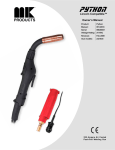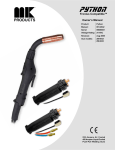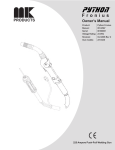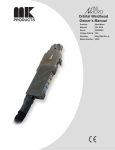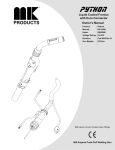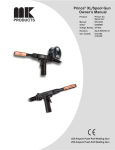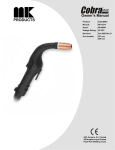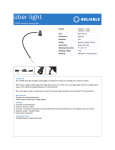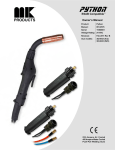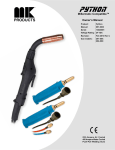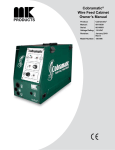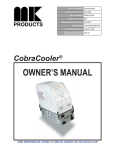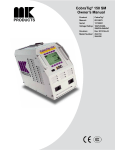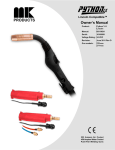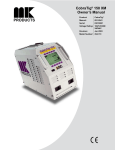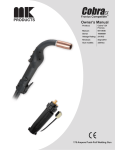Download Owner`s Manual DiamondBack™ Orbital Weldhead
Transcript
DiamondBack ™ Orbital Weldhead Owner’s Manual Product: DiamondBack Manual: 091-0511 Serial: 02100001 Voltage Rating: N/A Revision: June 2009 Rev C Model Number: 5006 Table of Contents Safety Guidelines..............................................................................i - iii Installation................................................................................ Section A Technical Specifications............................................................................................................... 1 Electrical................................................................................................................................ 1 Mechanical............................................................................................................................ 1 Weldhead Connections................................................................................................................ 1 Collet Selection & Adjustment...................................................................................................... 2 Tungsten Electrode Properties..................................................................................................... 2 Gas Flow Rates........................................................................................................................... 4 Operations................................................................................Section B Weldhead Calibration................................................................................................................... 5 Accessories..............................................................................Section C Benchmount................................................................................................................................. 5 Extension Cable........................................................................................................................... 5 Collets.......................................................................................................................................... 6 Maintenance.............................................................................Section D Preventative Maintenance........................................................................................................... 6 Rotor Accuracy............................................................................................................................. 6 Cable Assembly........................................................................................................................... 6 Troubleshooting........................................................................Section E Arc Start Troubleshooting............................................................................................................ 7 Operational Troubleshooting........................................................................................................ 7 Appendices...............................................................................Section F Diagram/Parts List....................................................................................................................... 9 Appendix A: Collets.................................................................................................................... 15 Appendix B: Pre-Ground Tungsten Electrodes.......................................................................... 15 Appendix C: Overall Dimenisonal Drawings.............................................................................. 16 Warranty Declaration of Conformity for European Community (CE) Products Note This information is provided for units with CE certification (see rating label on unit). Manufacturer’s Name: MK Products, Inc. 16882 Armstrong Ave. Irvine, CA 92606 Declares that the product: DiamondBack ™ conforms to the following Directives and Standards: Directives Low Voltage Directive: 73/23/EEC Electromagnetic Compatibility (EMC) Directive: 89/336/EEC Standards Arc Welding Equipment Part I: Welding Power Sources: IEC 60974-1 (September 1998 - Second Edition) Arc Welding Equipment: Wirefeed Systems: IEC 974-5 (September 1997 - Draft Revision) Degrees of Protection Provided by Enclosures (IP Code): IEC 529:1989 (November 1989 - First Edition) Insulation Coordination For Equipment With Low-Voltage Systems: Part I: Principles, Requirements and Tests: IEC 664-1: 1992 (October 1992 - First Edition) Electromagnetic Compatibility, (EMC): EN 50199 (August 1995) Torches And Guns For Arc Welding, EN 50078 SAFETY CONSIDERATIONS ELECTRIC ARC WELDING EQUIPMENT CAUTION : READ BEFORE ATTEMPTING INSTALLATION, OPERATION OR MAINTENANCE OF THIS EQUIPMENT 1-1 INTRODUCTION This equipment is intended for ultimate application by commercial/industrial users and for operation by persons trained and experienced in the use and maintenance of welding equipment. Operation should not be undertaken without adequate training in the use of such equipment. Training is available from many public and private schools or similar facilities. Safe practices in the installation, operation and maintenance of this equipment requires proper training in the art, a careful study of the information provided with the equipment, and the use of common sense. Rules for safe use are generally provided by suppliers of welding power sources, compressed gas suppliers, and electrode suppliers. Careful compliance with these rules will promote safe use of this equipment. The following Safety Rules cover some of the more generally found situations. READ THEM CAREFULLY. In case of any doubt, obtain qualified help before proceeding. 1-2 GENERAL PRECAUTIONS A. Burn Prevention ELECTRIC ARC WELDING PRODUCES H I G H I N T E N S I T Y H E AT A N D ULTRAVIOLET RADIANT ENERGY WHICH MAY CAUSE SERIOUS AND PERMANENT EYE DAMAGE AND WHICH MAY DAMAGE ANY EXPOSED SKIN AREAS. Wear helmet with safety goggles or glasses with side shields underneath, appropriate filter lenses or plates (protected by clear cover glass). This is a must for welding or cutting (and chipping) to protect the eyes from radiant energy and flying metal. Replace cover glass when broken, pitted, or spattered. Medical first aid and eye treatment. First aid facilities and a qualified first aid person should be available for each shift unless medical facilities are close by for immediate treatment of flash burns of the eyes and skin burns. Wear protective clothing - leather (or asbestos) gauntlet gloves, hat, and high safety-toe shoes. Button shirt collar and pocket flaps, and wear cuffless trousers to avoid entry of sparks and slag. Avoid oily or greasy clothing. A spark may ignite them. Flammable hair preparations should not be used by persons intending to weld or cut. Hot metal such as electrode stubs and work pieces should never be handled without gloves. Ear plugs should be worn when working on overhead or in a confined space. A hard hat should be worn when others work overhead. B. Toxic Fume Prevention WARNING: The use of this product may result in exposure to chemicals known to the State of California to cause cancer and birth defects or other reproductive harm. Adequate ventilation. Severe discomfort, illness or death can result from fumes, vapors, heat, or oxygen enrichment or depletion that welding (or cutting) may produce. Prevent them with adequate ventilation. NEVER ventilate with oxygen. C. Fire and Explosion Prevention Causes of fire and explosion are: combustibles reached by the arc, flame, flying sparks, hot slag, or heated material, misuse of compressed gases and cylinders, and short circuits. BE AWARE THAT flying sparks or falling slag can pass through cracks, along pipes, through windows or doors, and through wall or floor openings, out of sight of the goggled operator. Sparks can fly many feet. To prevent fires and explosion: Keep equipment clean and operable, free of oil, grease, and (in electrical parts) of metallic particles that can cause short circuits. Lead-, cadmium-, zinc-, mercury-, berylliumbearing and similar materials, when welded or cut, may produce harmful concentrations of toxic fumes. Adequate local exhaust ventilation must be used, or each person in the area, as well as the operator, must wear an air-supplied respirator. For beryllium, both must be used. If combustibles are in area, do NOT weld or cut. Move the work if practicable, to an area free of combustibles. Avoid paint spray rooms, dip tanks, storage areas, ventilators. If the work cannot be moved, move combustibles at least 35 feet away, out of reach of sparks and heat; or protect against ignition with suitable and snugfitting, fire-resistant covers or shields. Metals coated with or containing materials that emit toxic fumes should not be heated unless coating is removed form the work surface, the area is well ventilated, or the operator wears an air-supplied respirator. Walls touching combustibles on opposite sides should not be welded on (or cut). Walls, ceilings, and floor near work should be protected by heat-resistant covers or shields. Work in a confined space only while it is being ventilated and, if necessary, while wearing an air-supplied respirator. Fire watcher must be standing by with suitable fire extinguishing equipment during and for some time after welding or cutting if: Gas leaks in a confined space should be avoided. Leaked gas in large quantities can change oxygen concentration dangerously. Do not bring gas cylinders into a confined space. Leaving confined space, shut OFF gas supply at source to prevent possible accumulation of gases in the space if downstream valves have been accidentally opened or left open. Check to be sure that the space is safe before reentering it. Vapors from chlorinated solvents can be decomposed by the heat of the arc (or flame) to form PHOSGENE, a highly toxic gas, and other lung and eye irritating products. The ultraviolet (radiant) energy of the arc can also decompose trichloroethylene and perchloroethylene vapors to form phosgene. DO NOT WELD or cut where solvent vapors can be drawn into the welding or cutting atmosphere or where the radiant energy can penetrate to atmospheres containing even minute amounts of trichloroethylene or perchloroethylene. DiamondBack™ Owner’s Manual - Page i 1.Appreciable combustibles (including building construction) are within 35 feet. 2.Appreciable combustibles are further than 35 feet, but can be ignited by sparks. 3.Openings (concealed or visible) in floors or walls within 35 feet may expose combustibles to sparks. 4.Combustibles adjacent to walls, ceilings, roofs, or metal partitions can be ignited by radiant or conducted heat. Hot work permit should be obtained before operation to ensure supervisor’s approval that adequate precautions have been taken. After work is done, check that area is free of sparks, glowing embers, and flames. An empty container that held combustibles, or that can produce flammable or toxic vapors when heated, must never be welded on or cut, unless container has first been cleaned in accordance with industry standards. This includes: a thorough steam or caustic cleaning (or a solvent of water washing, depending on the combustible’s solubility), followed by purging and inerting with nitrogen or carbon dioxide, and using protective equipment. Water-filling just below working level may substitute for inerting. A container with unknown contents should be cleaned (see paragraph above). Do NOT depend on sense of smell or sight to determine if it is safe to weld or cut. Hollow castings or containers must be vented before welding or cutting. They can explode. Explosive atmospheres. NEVER weld or cut where the air may contain flammable dust, gas, or liquid vapors (such as gasoline). D. Compressed Gas Equipment The safe handling of compressed gas equipment is detailed in numerous industry publications. The following general rules cover many of the most common situations. 1. Pressure Regulators Regulator relief valve is designed to protect only the regulator from overpressure; it is not intended to protect any downstream equipment. Provide such protection with one or more relief devices. illegal and hazardous. Empties: Keep valves closed, replace caps securely; mark MT; keep them separate from FULLS, and return promptly. Prohibited use. Never use a cylinder or its contents for other than its intended use, NEVER as a support or roller. Locate or secure cylinders so they cannot be knocked over. Passageways and work areas. Keep cylinders clear of areas where they may be stuck. Transporting cylinders. With a crane, use a secure support such as a platform or cradle. Do NOT lift cylinders off the ground by their valves or caps, or by chains, slings, or magnets. Do NOT expose cylinders to excessive heat, sparks, slag, and flame, etc. that may cause rupture. Do not allow contents to exceed 55° C (130° F.) Cool with water spray where such exposure exists. Protect cylinders, particularly valves from bumps, falls, falling objects, and weather. Replace caps securely when moving cylinders. Stuck valve. Do NOT use a hammer or wrench to open a cylinder valve that cannot be opened by hand. Notify your supplier. sources of ignition. Wipe with a clean, lintless cloth. Match regulator to cylinder. Before connecting, check that the regulator label and cylinder marking agree, and that the regulator inlet and cylinder outlet match. NEVER Connect a regulator designed for a particular gas or gases to a cylinder containing any other gas. Tighten connections. When assembling threaded connections, clean and smooth seats where necessary. Tighten. If connection leaks, disassemble, clean, and retighten, using properly fitting wrench. Adapters. Use a CGA adapter (available from your supplier) between cylinder and regulator, if one is required. Use two wrenches to tighten adapter marked RIGHT and LEFT HAND threads. Regulator outlet (or hose) connections may be identified by right hand threads for oxygen and left hand threads (with grooved hex on nut or shank) for fuel gas. 5. Pressurizing Steps: Drain regulator of residual gas through suitable vent before opening cylinder (or manifold valve) by turning adjusting screw in (clockwise). Draining prevents excessive compression heat at high pressure seat by allowing seat to open on pressurization. Leave adjusting screw engaged slightly on single-stage regulators. Never connect a regulator to a cylinder containing gas other than that for which the regulator was designed. Mixing gases. NEVER try to mix any gases in a cylinder. Remove faulty regulator from service immediately for repair (first close cylinder valve). The following symptoms indicate a faulty regulator: Cylinder fittings should never be modified or exchanged. Stand to side of regulator while opening cylinder valve. Excessive Creep - if delivery pressure continues to rise with downstream valve closed. 3. Hose Prohibited use. Never use hose other than that designed for the specified gas. A general hose identification rule is: red for fuel gas, green for oxygen, and black for inert gases. Faulty Gauge - if gauge pointer does not move off stop pin when pressurized, nor returns to stop pin after pressure release. Use ferrules or clamps designed for the hose (not ordinary wire or other substitute) as a binding to connect hoses to fittings. Open cylinder valve slowly so that regulator pressure increases slowly. When gauge is pressurized (gauge reaches regulator maximum) leave cylinder valve in following position: for oxygen and inert gases, open fully to seal stem against possible leak; for fuel gas, open to less than one turn to permit quick emergency shut-off. Repair. Do NOT attempt repair. Send faulty regulators for repair to manufacturer’s designated repair center, where special techniques and tools are used by trained personnel. No copper tubing splices. Use only standard brass fittings to splice hose. Leaks - if gas leaks externally. 2. Cylinders Cylinders must be handled carefully to prevent leaks and damage to their walls, valves, or safety devices: Avoid electrical circuit contact with cylinders including third rails, electrical wires, or welding circuits. They can produced short circuit arcs that may lead to a serious accident. (See 1-3C) ICC or DOT marking must be on each cylinder. It is an assurance of safety when the cylinder is properly handled. Identifying gas content. Use only cylinders with name of gas marked on them; do not rely on color to identify gas content. Notify supplier if unmarked. NEVER DEFACE or alter name, number, or other markings on a cylinder. It is NEVER refill any cylinder. Avoid long runs to prevent kinks and abuse. Suspend hose off ground to keep it from being run over, stepped on, or otherwise damaged. Coil excess hose to prevent kinks and tangles. Protect hose from damage by sharp edges, and by sparks, slag, and open flame. Examine hose regularly for leaks, wear, and loose connections. Immerse pressured hose in water; bubbles indicate leaks Repair leaky or worn hose by cutting area out and splicing. Do NOT use tape. 4. Proper Connections Clean cylinder valve outlet of impurities that may clog orifices and damage seats before connecting regulator. Except for hydrogen, crack valve momentarily, pointing outlet away from people and DiamondBack™ Owner’s Manual - Page ii Use pressure charts (available from your supplier) for safe and efficient recommended pressure settings on regulators. Check for leaks on first pressurization and regularly thereafter. Brush with soap solution. Bubbles indicate leaks. Clean off soapy water after test; dried soap is combustible. E. User Responsibilities Follow all Safety Rules. Remove leaky or defective equipment from service immediately for repair. Read and follow user manual instructions. F. Leaving Equipment Unattended Close gas supply at source and drain gas. G. Rope Staging-Support Rope staging-support should not be used for welding or cutting operation; rope may burn. 1-3 ARC WELDING Comply with precautions in 1-1, 1-2, and this section. Arc Welding, properly done, is a safe process, but a careless operator invites trouble. The equipment carries high currents at significant voltages. The arc is very bright and hot. Sparks fly, fumes rise, ultraviolet and infrared energy radiates, weldments are hot, and compressed gases may be used. The wise operator avoids unnecessary risks and protects himself and others from accidents. A. Burn Protection Comply with precautions in 1-2. The welding arc is intense and visibly bright. Its radiation can damage eyes, penetrate lightweight clothing, reflect from light-colored surfaces, and burn the skin and eyes. Skin burns resemble acute sunburn; those from gas-shielded arcs are more severe and painful. DON’T GET BURNED; COMPLY WITH PRECAUTIONS. 1. Protective Clothing Wear long-sleeve clothing in addition to gloves, hat, and shoes. As necessary, use additional protective clothing such as leather jacket or sleeves, flameproof apron, and fire-resistant leggings. Avoid outer garments of untreated cotton. Bare skin protection. Wear dark, substantial clothing. Button collar to protect chest and neck, and button pockets to prevent entry of sparks. 2. Eye and Head Protection Protect eyes from exposure to arc. Eyes may be damaged by radiant energy when exposed to the electric arc, even when not looking in the direction of the arc. Never look at an electric arc without protection. Welding helmet or shield containing a filter plate shade no. 12 or denser must be used when welding. Place over face before striking arc. Protect filter plate with a clear cover plate. Cracked or broken helmet or shield should NOT be worn; radiation can be passed through to cause burns. Cracked, broken, or loose filter plates must be replaced IMMEDIATELY. Replace clear cover plate when broken, pitted, or spattered. Flash goggles with side shields MUST be worn under the helmet to give some protection to the eyes should the helmet not be lowered over the face before an arc is struck. Looking at an arc momentarily with unprotected eyes (particularly a high intensity gas-shielded arc) can cause a retinal burn that may leave a permanent dark area in the field of vision. 3. Protection of Nearby Personnel Enclose the welding area. For production welding, a separate room or enclosed bay is best. In open areas, surround the operation with low-reflective, noncombustible screens or panels. Allow for free air circulation, particularly at floor level. Viewing the weld. Provide face shields for all persons who will be looking directly at the weld. at connections. Others working in area. See that all persons are wearing flash goggles. If a line cord with a ground lead is provided with the equipment for connection to a switch box, connect the ground lead to the grounded switch box. If a threeprong plug is added for connection to a grounded mating receptacle, the ground lead must be connected to the ground prong only. If the line cord comes with a three-prong plug, connect to a grounded mating receptacle. Never remove the ground prong from a plug, or use a plug with a broken ground prong. Before starting to weld, make sure that screen flaps or bay doors are closed. B. Toxic Fume Prevention Comply with precautions in 1-2B. Generator engine exhaust must be vented to the outside air. Carbon monoxide can kill. C. Fire and Explosion Prevention Comply with precautions in 1-2C. Equipment’s rated capacity. Do not overload arc welding equipment. It may overheat cables and cause a fire. Loose cable connections may overheat or flash and cause afire. Never strike an arc on a cylinder or other pressure vessel. It creates a brittle area that can cause a violent rupture or lead to such a rupture later under rough handling. D. Compressed Gas Equipment Comply with precautions in 1-2D. E. Shock Prevention Exposed electrically hot conductors or other bare metal in the welding circuit, or in ungrounded, electrically-HOT equipment can fatally shock a person whose body becomes a conductor. DO NOT STAND, SIT, LIE, LEAN ON, OR TOUCH a wet surface when welding without suitable protection. To protect against shock: Keep body and clothing dry. Never work in damp area without adequate insulation against electrical shock. Stay on a dry duckboard, or rubber mat when dampness or sweat cannot be avoided. Sweat, sea water, or moisture between body and an electrically HOT part - or grounded metal - reduces the body surface electrical resistance, enabling dangerous and possibly lethal currents to flow through the body. 1. Grounding the Equipment When installing, connect the frames of each unit such as welding power source, control, work table, and water circulator to the building ground. Conductors must be adequate to carry ground currents safely. Equipment made electrically HOT by stray currents may shock, possibly fatally. Do NOT GROUND to electrical conduit, or to a pipe carrying ANY gas or a flammable liquid such as oil or fuel. Three-phase connection. Check phase requirement of equipment before installing. If only three-phase power is available, connect single-phase equipment to only two wires of the three-phase line. Do NOT connect the equipment ground lead to the third (live) wire, or the equipment will become electrically HOT - a dangerous condition that can shock, possibly fatally. Before welding, check ground for continuity. Be sure conductors are touching bare metal of equipment frames DiamondBack™ Owner’s Manual - Page iii 2. Connectors Fully insulated lock-type connectors should be used to join welding cable lengths. 3. Cables Frequently inspect cables for wear, cracks, and damage. IMMEDIATELY REPLACE those with excessively worn or damaged insulation to avoid possibly lethal shock from bared cable. Cables with damaged areas may be taped to give resistance equivalent to original cable. Keep cable dry, free of oil and grease, and protected from hot metal and sparks. 4. Terminals and Other Exposed Parts Terminals and other exposed parts of electrical units should have insulating covers secured before operation. 5. Electrode Wire Electrode wire becomes electrically HOT when the power switch of gas metal-arc welding equipment is ON and welding gun trigger is pressed. Keep hands and body clear of wire and other HOT parts. 6. Safety Devices Safety devices such as interlocks and circuit breakers should not be disconnected or shunted out. Before installation, inspection, or service of equipment, shut OFF all power, and remove line fuses (or lock or red-tag switches) to prevent accidental turning ON of power. Disconnect all cables from welding power source, and pull all 115 volts line-cord plugs. Do not open power circuit or change polarity while welding. If, in an emergency, it must be disconnected, guard against shock burns or flash from switch arcing. Leaving equipment unattended. Always shut OFF, and disconnect all power to equipment. Power disconnect switch must be available near the welding power source. Thank You For selecting a quality product. We want you to take pride in operating this product...as much pride as we have in bringing the product to you! Please Examine Carton and Equipment For Damage Immediately When this equipment is shipped, title passes to the purchaser upon receipt by the carrier. Consequently, claims for material damaged in shipment must be made by the purchaser against the transportation company at the time the shipment is received. Please record your equipment identification information below for future reference. This information can be found on your machine nameplate. Model Name & Number _____________________ Code & Serial Number _____________________ Date of Purchase _____________________ Whenever you request replacements parts for, or information on this equipment always supply the information you have recorded above. Read this Owner’s Manual completely before attempting to use this equipment. Save this manual and keep it handy for quick reference. Pay particular attention to the safety instructions we have provided for your protection. Section A Installation Technical Specifications The DiamondBack™ weldhead was designed for process piping and manufacturing work-cell applications. The DiamondBack™ weldhead is capable of welding 2” Tube OD to 6” Nominal Pipe and associated fittings. Electrical The DiamondBack™ uses a 24VDC motor with TACH feedback. It is controlled by an orbital power-supply motor-control circuit to turn the rotor at the precise speed to create a near perfect weld. Mechanical Power Cable Size:������������������ #6, 75A, 600V. Twist-lock cable-end connectors. Gas/Water Hose Size:������������ Nylon Tube, ¼” OD x 0.17 ID Double-end shut-off coupler Control Cable Specification:��� 20AWG, 12 conductor Weldhead Connections The DiamondBack™ comes equipped with an integrated 25 foot cable, which connects to the CobraTig® 150 orbital power-supply. The cable assembly provides a path for weld power, operator control and motor signals and inert gas flow (see Figure 1). Figure 1 ® Connecting to the CobraTig 150 The DiamondBack™ connects directly to the CobraTig® 150 orbital power supply. Welding Leads The two welding Power Leads use a twist-lock type of power connector. These are designed to attach directly to the rear panel of the CobraTig® 150. The male connector connects to the receptacle labeled “ELECTRODE”. The female connector connects to the receptacle labeled “GROUND”. Control Cable The 24 MS-type pin connector attaches to the mating receptacle on the rear panel of the orbital welding powersupply. All of the Control, Feedback and Welding functions of the weldhead transfer through this connector. The operator controls are on the weldhead handle. They include: JOG, GAS/NEXT LEVEL, FINAL SLOPE and START/STOP (Figure 2). Figure 2 Gas Hose The gas connector is a double-end shut-off type valve that prevents flow or leakage out of either the unit or the gas hose if the connection is broken. The gas hose connector from the weldhead plugs into the “GAS OUT” receptacle. DiamondBack™ Owner’s Manual - Page 1 Collet Selection The three-piece collet assembly mounts to both the jaws and the bottom face plate of the weldhead and maintains the weld joint alignment of the parts to be welded. The collets are manufactured to correspond with the outside diameter of the material to be welded. Each set of collets has three pieces; two sides and one bottom. Two sets of collets are needed to weld two tubes together. Appendix A lists collet part numbers for tube and pipe. Collet Adjustment The parts to be welded are held in place by the Collets. The tolerance of the outside diameter of tubes and pipes vary, so these variations are handled through the use of brass-tipped setscrews, referred to as plungers, in the top Collet halves. These plungers not only make up the diameter difference between the Collet and the part to be welded, but they also act as an aid in the grounding path between the weldhead and the tube or pipe to be welded. The tube or pipe is forced down into the bottom third of the collets, which are screwed to a line-bored concentric face in the weldhead side-plates. The plungers are adjusted as follows: 1. Back the plungers out until the brass tip is flush or below the surface of the bored Collet surface. 2. Place the parts to be welded into the Collets and clamp down the latches. Adjust the latching mechanism of the weldhead to ensure a tight, but not overly-tight clamping of the Side Plate Jaws. 3. Alternately adjust the plungers on one side of the weldhead until contact is made, and then add about 1/4 turn more. 4. At this point the tube should be firmly held in place. The tube should not turn if attempting to rotate it by hand. 5. Repeat the process for the opposite side of the weldhead. 6. Once completed, check the alignment of the parts. A misalignment may be corrected by moving the left or right plunger in or out by a fraction of a turn and then repeating the opposite action to the opposing plunger on the same Collet. Tungsten Electrode Properties The recommended tungsten type to be used in the DiamondBack™ and the MK Orbital Welding System is 2% Ceriated, 3/32 inch diameter. 1/16 inch diameter tungsten is also available for the DiamondBack™ orbital weldhead. Appendix B gives the MK part numbers for pre-ground tungsten electrodes and an illustrated formula to determine the length of tungsten electrode required using a given weldhead size with a specified tube or pipe diameter. These lengths of tungsten are long enough to allow the setscrew to securely hold the tungsten while maintaining a relatively close arc gap, and keep the tungsten from sticking out the back of the rotor while using a large arc gap. Tungsten Geometry The recommended grind angle and shape for tungsten is 18° included angle and a .015 inch flat (Figure 3). Regardless of the electrode tip geometry selected; it is important that consistent electrode geometry be used once a welding procedure is established. Figure 3 DiamondBack™ Owner’s Manual - Page 2 Changes in electrode geometry can significantly influence the weld bead shape and size; therefore, electrode tip configuration is a welding variable that should be defined during procedure development. Tungsten Preparation Tungsten electrodes should be properly ground for consistent results. If the electrode is to be hand ground, use a dedicated diamond wheel. The grinding marks should be perpendicular to the tungsten electrode or poor arc starts, arc wander and inclusions may occur (See Figure 4). No other parts should be ground with these wheels, since contamination of the electrode could result and create problems with arc initiation, arc wander during the weld and tungsten inclusions in the weld bead. All tungsten supplied by MK Products, Inc. is prepared using the latest manufacturing techniques in order to meet the geometry specifications as described above. Figure 4 Installing the Tungsten Electrode The electrode is mounted in the rotor and held in place with a setscrew. To insert the electrode, jog the rotor around until the setscrew is exposed (approximately at the twelve-o’clock position), and loosen the setscrew. Insert a properly prepared electrode from the top of the rotor and tighten the setscrew. Be sure to set the appropriate arc gap prior to welding. Setting the Arc Gap 1. Place the part to be welded on the lower Collets with the clamps in the upright open position. 2. Jog the rotor until the tungsten hole in the rotor is sitting directly over the part with access to the tungsten set screw, approximately at twelveo’clock. 3. Prepare the tungsten electrode with the right length and shape as explained in the Tungsten Geometry and Tungsten Preparation sections. 4. Put the tungsten electrode through the appropriate hole on the top of the rotor. 5. Place the appropriate thickness gauge between the tungsten electrode and the part to be welded so that the tungsten electrode is at the correct gap. Be certain the thickness gauge is perpendicular to the tungsten electrode. 6. Tighten the setscrew to secure the tungsten electrode in the rotor. DiamondBack™ Owner’s Manual - Page 3 Recommended Arc Gap The proper arc gap is an important part of the proper use of your orbital welding equipment. Improper arc gap can cause arc strikes to occur to your Collets. Be sure the arc gap is as short as possible, consistent with the process and weld current level, but not so short as to ‘crash’ or touch the weld being made. If no arc gap is known when designing a weld procedure a good rule-ofthumb is as follows: Work Cell Apps: (Wall Thickness x 0.5) + 0.010”. Field Apps: Match Arc Gap to Wall Thickness, up to max. gap of .070”* * Some applications may require variance on this dimension depending on pipe concentricity and ovality. CAUTION Do not over-tighten the tungsten set screw. Over-tightening the setscrew can crack and splinter the tungsten causing errant starts and arc wander. Be sure that the tungsten does not extend into the rotor teeth and that both setscrews are flush with the rotors surface. Any length of tungsten that is protruding out the back of the rotor will jam with the meshing gears inside the weldhead. This will push the tungsten into the weld being made and inevitably cause either an ARC FAULT or MOTOR FAULT, or worse. If the weldhead becomes jammed, a “Motor Stall” will result. Usually, some foreign matter, or a piece of tungsten electrode has fallen within the gear mechanism of the weldhead, hindering the rotation of the gears. Clearing a Jammed Weldhead In order to clear the jam, turn the weldhead upside-down and vigorously shake the weldhead. Another way to attempt removal of the foreign matter is to jog the rotor in the reverse direction. This is accomplished by depressing the reverse direction button. Locate the red button through the hole in the bottom of the handle. This is a momentary reverse switch, which means the rotor will reverse momentarily when the JOG button is pressed while holding the red button down. Before turning the weldhead right side up, attempt to locate the foreign object. If the jam cannot be cleared in this manner, the weldhead must be returned to MK for disassembly to have the objects removed. Gas Flow Rates Recommended arc gas flow rate is 35 CFH at 50 PSI using the CobraTig® 150 . Flow rates higher than 35 CFH can create turbulence within the weldhead chamber and blow the arc about. If more gas coverage is required, increase the pre-purge time on the CobraTig™. ® Back-up gas flow rates are typically between 5 and 20 CFH, depending on internal volume and component configuration. Typically, when welding components with relatively large internal volumes, a separate source for backup purge gas is recommended. NOTE: Disassembly of weldhead will void the warranty. DiamondBack™ Owner’s Manual - Page 4 Section B Operation Weldhead Calibration The software program in the orbital welding power-supply provides for weldhead rotor speed and motor controller calibration. This calibration program consists of driving the rotor at two predetermined speeds: 1.0 and 0.5 RPM. The start and end of each rotation are detected by the passage of the reed switch or “home” sensor in the weldhead. The rotation is clocked by the computer and, by process of adjusting and recalculating, provides very accurate and consistent speeds. NOTE: IT IS MANDATORY THAT THE WELDHEAD BE CALIBRATED EACH TIME THE SYSTEM IS TURNED ‘ON’. FAILURE TO CALIBRATE THE WELDHEAD MAY RESULT IN THE WELDHEAD OPERATING AT A “ROUGH” ADJUSTMENT THAT MAY NOT PROVIDE CORRECT ROTOR SPEED AGAINST THE CONTROLLERS’ DEMAND SPEED. CobraTig® 150 The report generated by this unit is not as elaborate as the report from the ACL, however; it does show some very important information. It shows both the MOTOR and TACH gain values. The calibration and adjustment is still the same. The Zero Offset for both the MOTOR and TACH is also shown: MOTOR Calibration report MOTOR gain: TACH gain: -4.6% Zero offset: 0.30 RPM 1.9% Zero offset: 0.02 RPM Should these MOTOR & TACH gain values return with number of 0.00% and 0.00 RPM, the calibration was invalid and should be re-run. Results containing all zeros are an indication that the weldhead is in need of service: MOTOR Calibration report MOTOR gain: TACH gain: 0.0% Zero offset: 0.00 RPM 0.0% Zero offset: 0.00 RPM NOTE: If all values for MOTOR or WELDER calibration are zeros, it means that weldhead calibration did not complete successfully and is not valid. A recalibration is highly reccomended at this time. Section C Accessories Table Edge Benchmount The DiamondBack™ weldhead can be used while held in the operator’s hand. However, due the weight and size of the weldhead, at times it may be necessary for the operator to use both hands to manipulate parts within the weldhead and which requires the use of a Table Edge Weldhead Benchmount. This Table Edge Benchmount, P/N 005-0680, can be affixed to any table or counter edge and can hold the DiamondBack™ Model 5006 orbital weldhead. Extension Cable When longer weldhead cables are needed, a weldhead extension cable is also available in a 25’ length. The extension cable (P/N 005-0635) has all the connections needed to connect the DiamondBack™ to the CobraTig 150: welding leads, gas, and control interface. ® DiamondBack™ Owner’s Manual - Page 5 Collets A set of Collets is defined as 3 each 120° segments for each side of the weldhead. Typically, 2 sets are required per each weldhead (See Appendix A for Part Numbers. Section D Maintenance Due to the complexity of the DiamondBack™ ; there is no maintenance permitted for the DiamondBack™ with the exception of preventive maintenance, adjustments and replacement of consumables. NOTE: Disassembly of weldhead will void the warranty. Preventative Maintenance Prior to performing any maintenance, the weldhead should be tested to “benchmark” its performance. A normal calibration should be run and the required correction noted. If the weldhead is running slowly or sluggishly, this usually indicates that there is an excessive load on the drive motor, and that maintenance is required. Rotor Accuracy Weld uniformity depends on the accuracy of the position of the rotor during welding. Rotor rotation should be circular in motion in a plane at right angles to the tube and concentric with the center of the tube to be welded. Any deviation from the proper tracking or discontinuity in the rotor will appear in the weld. Problems in the plane of rotation are usually associated with Collets and can be corrected by Collet modification. Discontinuities with rotor motion are more serious and may require replacement of the rotor, the race, or both. Proper replacement requires factory tooling and is not a field repair. Cable Assembly An electrical measurement should be made to determine continuity from the positive cable connector to the rotor and from the negative cable connector to the jaws on the weldhead. Resistance measurements should be less than 0.1 ohms. A measurement should also be made to verify that no conductivity exists between the positive and negative power cables. Any measurable conductivity through the weldhead will severely reduce arc start reliability. The resistance measurement must be greater than 20 MΩ when measured between the tungsten and the jaws. A visual inspection should be made to determine the condition of the weldhead and the cable assembly. If there are damaged or worn items, the weldhead should be returned for factory service. DiamondBack™ Owner’s Manual - Page 6 Section E Troubleshooting Arc Start Troubleshooting If you experience intermittent arc start problems or strikes to the Collet or Side Plate Clamp instead of the part to be welded, check for the following: 1. The proper arc gap is an important part of the proper use of your MK Orbital equipment. Improper arc gap can cause arc strikes to occur to your Side Plate Clamp or Collets. 2. Be sure that the tungsten is ground properly, (18° included angle and a .015” - .017” flat at the end of the tip). Sharpening should be accomplished with the grind marks parallel to the longitudinal axis of the tungsten, not around the tungsten (reference Figure 3). 3. Parts must be clean with no oxidation, oils, solvents or other insulating surface contaminant. 4. If the tungsten is contaminated at any time, it should be replaced. Dirty tungsten can cause poor arc starts and tungsten inclusions. 5. Make sure that the part to be welded is tight in the Collets, or a loose ground will result. If the part to be welded can be turned in a latched Collet, tighten the Collet plungers. 6. Avoid any tooling that might have sharp edges or points or this will cause an arc strike to the Collets or the Side Plate Clamp. 7. To insure reliable arc starting and extended tungsten life, the pre-purge settings should be determined by the size of the tube and weldhead size: the smaller the tube in a given size weldhead; the longer the pre-purge time. 8. If an arc strike occurs to the Collet or Side Plate Clamp, the resulting arc spot may induce future arc strikes. Be sure to smooth out any arc spots with a fine abrasive pad or cover it with appropriate insulating tape. 9. Be sure that there is a tube in the weldhead before trying to make a weld. Operational Troubleshooting If the weldhead does not return to the ‘Home’ position, but continues to rotate when the ‘Home’ switch is pressed; the Reed Switch is most likely defective. The DiamondBack™ weldhead must be returned to the factory for any and all repairs. NOTE: Disassembly of weldhead will void the warranty. DiamondBack™ Owner’s Manual - Page 7 THIS PAGE INTENTIONALLY BLANK Section F Appendices Exploded View...........................................................................11 Bill of Material.............................................................................11 Assembly Motor Mount..............................................................13 Assembly Leads.........................................................................14 Appendix A: Collets....................................................................15 Appendix B: Pre-Ground Tungsten Electrodes..........................15 Appendix C: Overall Dimensional Drawings..............................16 DiamondBack™ Owner’s Manual - Page 9 THIS PAGE INTENTIONALLY BLANK DiamondBack™ Weldhead Exploded View Exploded View No. Qty. Part No. Description 1 1 002-0650 Assy Brush Plate 2 1 003-2142 Assy PCB DiamondBack 3 1 003-2162 Assy Rotor 4 1 003-2163 Assy Clamp Right 5 1 003-2164 Assy Clamp Left 6 1 003-2165 Assy Motor Mount 7 1 003-2166 Assy Gear Spur Bevel 8 1 003-2167 Assy Reed Swx 9 1 003-2169 Assy Lead DiamondBack 10 2 003-2171 Assy Gear 48T 11 2 003-2172 Assy Gear 84T 12 1 003-2173 Assy Hub Gear Bevel 13 19 318-0004 Scr F Slot 4-40 x 1/4 82° NYL 14 2 319-0019 Scr F SK 82D 8-32 x 3/4 15 4 319-0024 Scr F SK 82D 10-24 x 3/4 16 20 319-0025 Scr F SK 82D 10-24 x 1.0 17 4 319-0038 Scr F SK 82D 1/4-20 x 3/4 18 6 338-0020 Scr SHC 6-32 x 1/4 SST 19 2 328-0026 Scr SHC 8-32 x 5/8 20 4 328-0036 Scr SHC 10-24 x 1/2 ST 21 6 328-0043 Scr SHC 10-24 x 1 3/4 22 2 328-0237 Scr SHC 4-40 x 1/4 SST 23 2 330-0005 Scr SHDR 10-24 x 1/4 x 1 24 3 331-0036 Wshr Flat 0.310 x 0.19 x 0.032 25 2 333-0045 Washer LK Star-IN #10 26 3 336-0027 Scr PN P 8-32 x 1/4 ST 27 2 336-0155 Scr PN P 10-32 x 0.375 SST 28 1 341-0072 Nut Hex 10-32 SST 29 1 405-0958 Switch Membrane Panel Assy 30 9 419-0063 SPG Comp 1/8 OD x 17/64 LG SST 31 2 419-0097 SPG Comp 0.36 OD x 0.29 ID 32 4 421-0714 Pin Dowel 1/8 x 5/16 SST 4 421-0730 Pin Dowel 3/16 x 5/8 SST 33 34 1 421-0733 Pin Dowel 3/16 x 1 1/8 SST 35 1 421-0742 Pin Detent 36 4 421-3111 Pin Dowel 3/16 x 7/8 SST 37 1 431-1670 Base Gear G10 5006 38 1 431-1671 Cover Gear 6 IN 39 1 431-1672 Sideplate Right 40 1 431-1673 Sideplate Left 41 2 431-1676 Clamp Bottom 42 1 431-1681 Pivot Mount 43 1 431-1682 Housing Control Right 44 1 431-1683 Housing Control Left 45 1 431-1684 Strain Relief Clamp Base 46 1 431-1685 Strain Relief Clamp Bar 47 2 431-1693 Bezel Weld Lens 48 1 431-1694 Race Teflon 49 3 431-1698 Bshg FLG 5/16-18 SS DBack 50 3 431-1699 Bshg FLG PVT SS DBack 51 1 431-1701 Strap Ground DiamondBack 52 1 431-1704 Fitting Gas Barbed DBack 53 3 431-1705 Scr Sldr Mod 0.375 x 2.5 54 8 435-1201 Shim 1.25 OD x 0.391 ID x 0.01 55 1 435-1202 Clamp Reed Swx 56 5 435-1203 Shim 1.25 OD x 0.193 ID x 0.01 57 1 435-1204 Shim 1.25 OD x 0.250 ID x 0.01 58 2 435-1205 Window Weld View DiamondBack™ Owner’s Manual - Page 11 THIS PAGE INTENTIONALLY BLANK DiamondBack™ Owner’s Manual - Page 12 DiamondBack™ Assembly Motor Mount P/N 003-2165 Assembly Motor Mount No. Qty. Part No. 1 4 153-0853 Pin Crimp 2 1 153-0902 Conn Single Row 4P 3 1 211-0078 Motor Pittman Gear 581:1 4 3 328-0003 Scr Shc 4-40 x 1/2 5 2 421-0129 Pin Spring 0.063 x 0.437 6 2 421-0426 Pin Dowel 1/4 x 7/8 SST 7 1 431-1690 Block Motor Mount 8 1 431-1702 Coupler Motor Gear 9 1 431-1708 Mod Gear Pinion 30T 10 1 431-1709 Spacer Motor Mount Description DiamondBack™ Owner’s Manual - Page 13 DiamondBack™ Assembly Lead P/N 003-2169 After installing leads, secure snakeskin cover with tie wraps Assembly Lead No. Qty. Part No. 1 1 552-0221 Gas Hose 2 1 843-0692 Cable Ground 25 ft 3 1 843-0691 Cable Electrode 25 ft 4 1 301-0225 Snake Skin Cover 5 1 843-0564 Cable Controller DiamondBack 6 2 411-0202 Tie Wrap Description DiamondBack™ Owner’s Manual - Page 14 Appendix A Collets Diameter - Tube OD 2” 2-1/2” 3” 3-1/2” 4” 4-1/2” 5” 5-1/2” 6” Diameter - NPS 2” 2-1/2” 3” 3-1/2” 4” 5” 5-1/2" 6” Diameter - Metric Tube 114.0 115.0 60.0 72.0 78.8 Description COL 5006 FLS 2 IN OD COL 5006 FLS 2-1/2 IN OD COL 5006 FLS 3 IN OD COL 5006 FLS 3-1/2 IN OD COL 5006 FLS 4 IN OD COL 5006 FLS 4-1/2 IN OD COL 5006 FLS 5 IN OD COL 5006 FLS 5-1/2 IN OD COL 5006 FLS 6 IN OD Description COL 5006 FLS 2 IN NP COL 5006 FLS 2-1/2 IN NP COL 5006 FLS 3 IN NP COL 5006 FLS 3-1/2 IN NP COL 5006 FLS 4 IN NP COL 5006 FLS 5 IN NP COL 5006 FLS 5-1/2 IN NP COL 5006 FLS 6 IN NP Description COL 5006 FLS 114.0MM OD COL 5006 FLS 115.0MM OD COL 5006 FLS 60.0MM OD COL 5006 FLS 72.0MM OD COL 5006 FLS 78.8MM OD Part Number 623-5006-2.000 623-5006-2.500 623-5006-3.000 623-5006-3.500 623-5006-4.000 623-5006-4.500 623-5006-5.000 623-5006-5.500 623-5006-6.000 Part Number 623-5006-2NP 623-5006-2-1/2NP 623-5006-3NP 623-5006-3-1/2NP 623-5006-4NP 623-5006-5NP 623-5006-5-1/2NP 623-5006-6NP Part Number 623-5006-114.0MM 623-5006-115.0MM 623-5006-60.0MM 623-5006-72.0MM 623-5006-78.8MM Collets screws (reference #18 in previous drawing) = 338-0020 Collets requiring sizes other then those listed above, are considered ‘Custom Collets’. Please consult factory for part number and pricing of ‘Custom Collets’. Blank collets for the 5006 DiamondBack™ weldhead are not available. Appendix B Pre-Ground Tungsten Electrodes Tungsten set screw = 321-1264 Diameter - Tube OD 2” 21/2” 3” 3-1/2” 4” 4-1/2” 5” 5-1/2” 6” Diameter - NPS 2” 2-1/2” 3” 3-1/2” 4” 5” 6” Diameter - Metric Tube 60.0 72.0 78.8 114.0 115.0 Description TUNG 3/32 5006 2 OD TUNG 3/32 5006 2-1/2 OD TUNG 3/32 5006 3 OD TUNG 3/32 5006 3-1/2 OD TUNG 3/32 5006 4 OD TUNG 3/32 5006 4-1/2 OD TUNG 3/32 5006 5 OD TUNG 3/32 5006 5-1/2 OD TUNG 3/32 5006 6 OD Description TUNG 3/32 5006 2 NP TUNG 3/32 5006 2-1/2 NP TUNG 3/32 5006 3 NP TUNG 3/32 5006 3-1/2 NP TUNG 3/32 5006 4 NP TUNG 3/32 5006 5 NP TUNG 3/32 5006 6 NP Description TUNG 3/32 5006 60.0 MM OD TUNG 3/32 5006 72.0 MM OD TUNG 3/32 5006 78.8 MM OD TUNG 3/32 5006 114.0 MM OD TUNG 3/32 5006 115.0 MM OD DiamondBack™ Owner’s Manual - Page 15 Part Number 635-093-3.339 635-093-3.089 635-093-2.828 635-093-2.578 635-093-2.328 635-093-2.086 635-093-1.828 635-093-1.578 635-093-1.332 Part Number 635-093-3.147 635-093-2.890 635-093-2.578 635-093-2.328 635-093-2.067 635-093-1.531 635-093-1.000 Part Number 635-093-3.147 635-093-2.890 635-093-2.781 635-093-2.086 635-093-2.067 Appendix C Overall Dimensional Drawings Side View - Closed Side View - Open Side View - 90° Tilted DiamondBack™ Owner’s Manual - Page 16 Appendix C Overall Dimensional Drawings Profile - without Collets Profile - with Collets Specifications subject to change without notice. Dimensions provided are for reference only. DiamondBack™ Owner’s Manual - Page 17 DiamondBack™ Owner’s Manual - Page 18 DiamondBack™ Owner’s Manual - Page 19 LIMITED WARRANTY Effective August 1, 2008 This warranty supersedes all previous MK Products warranties and is exclusive, with no other guarantees or warranties expressed or implied. LIMITED WARRANTY - MK Products Inc., Irvine, California warrants that all new and unused equipment furnished by MK Products is free from defects in workmanship and material as of the time and place of delivery by MK Products. No warranty is made by MK Products with respect to trade accessories or other items manufactured by others. Such trade accessories and other items are sold subject to the warranties of their respective manufacturers, if any. MK Products’ warranty does not apply to components having normal useful life of less than one (1) year, such as relay points, wire conduit, tungsten, and welding gun parts that come in contact with the welding wire, including gas cups, gas cup insulators, and contact tips where failure does not result from defect in workmanship or material. MK Products shall, exclusively remedy the limited warranty or any duties with respect to the quality of goods, based upon the following options: (1) repair (2) replacement (3) where authorized in writing by MK Products, the reasonable cost of repair or replacement at our Irvine, California plant. As a matter of general policy only, MK Products may honor an original user’s warranty claims on warranted equipment in the event of failure resulting from a defect within the following periods from the date of delivery of equipment to the original user: 1. Power Supplies and Wire Feed Cabinets ..................3 years 2. Weldheads, CobraCooler, Positioners, Prince XL and Prince XL Spool Guns, Python, CobraMAX, Cobra SX, Cobra MX ....................................................................1 year 3. Sidewinder Spool Gun, Prince SG Spool Guns, Modules ...... ............................................................................... 180 days 4. Repairs/Exchanges/Parts/Accessories .................. 90 days 16882 Armstrong Ave. Irvine, CA 92606 Tel (949) 863-1234 Fax (949) 474-1428 www.mkproducts.com 16882 Armstrong Ave. Irvine, CA 92606 Tel (949)863-1234 Fax (949)474-1428 www.mkproducts.com Classification of any item into the foregoing categories shall be at the sole discretion of MK Products. Notification of any failure must be made in writing within 30 days of such failure. A copy of the invoice showing the date of sale must accompany products returned for warranty repair or replacement. All equipment returned to MK Products for service must be properly packaged to guard against damage from shipping. MK Products will not be responsible for any damages resulting from shipping. Normal surface transportation charges (one way) for products returned for warranty repair or replacement will be borne by MK Products, except for products sold to foreign markets. ANY EXPRESS WARRANTY NOT PROVIDED HEREIN AND ANY IMPLIED WARRANTY, GUARANTY, OR REPRESENTATION AS TO PERFORMANCE, AND ANY REMEDY FOR BREACH OF CONTRACT WHICH, BUT FOR THIS PROVISION, MIGHT ARISE BY IMPLICATION, OPERATION OF LAW, CUSTOM OF TRADE, OR COURSE OF DEALING, INCLUDING ANY IMPLIED WARRANTY OF MERCHANTABILITY OR OF FITNESS FOR PARTICULAR PURPOSE, WITH RESPECT TO ANY AND ALL EQUIPMENT FURNISHED BY MK PRODUCTS, IS EXCLUDED AND DISCLAIMED BY MK PRODUCTS. EXCEPT AS EXPRESSLY PROVIDED BY MK PRODUCTS IN WRITING, MK’s PRODUCTS ARE INTENDED FOR ULTIMATE PURCHASE BY COMMERCIAL/INDUSTRIAL USERS AND FOR OPERATION BY PERSONS TRAINED AND EXPERIENCED IN THE USE AND MAINTENANCE OF WELDING EQUIPMENT AND NOT FOR CONSUMERS OR CONSUMER USE. MK PRODUCTS’ WARRANTIES DO NOT EXTEND TO, AND NO RE-SELLER IS AUTHORIZED TO EXTEND MK PRODUCTS’ WARRANTIES TO ANY CONSUMER. USE OF OTHER THAN GENUINE MK PRODUCTS’ CONSUMABLES, PARTS, AND ACCESSORIES MAY INVALIDATE YOUR PRODUCT WARRANTY. August 1, 2008 Rev. A August 1, 2008 Rev. A THIS PAGE INTENTIONALLY BLANK www.mkproducts.com 16882 Armstrong Ave. Irvine, California 92606 TEL (949) 863-1234 • FAX (949) 474-1428






























